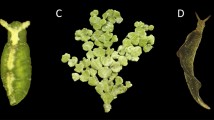Abstract
We investigated mycosporine amino acid (MAA) involvement as protective sunscreens in spawn of the sea hare Aplysia dactylomela to determine if adult diet and ultraviolet (UV) exposure affected the UV sensitivity of developing embryos. Adults were fed a red alga rich in MAAs (Acanthophora spicifera) or a green alga poor in MAAs (Ulva lactuca). Adults on each diet were exposed for 2 wk to ambient solar irradiance with two types of acrylic filters; one allowed exposure to wavelengths >275 nm (designated UV) and one to wavelengths only >410 nm (designated NOUV). Spawn from each adult group was likewise treated with UV or NOUV and monitored during development for differences in mortality and metabolic rate (measured as oxygen consumption: V˙ O2). Also recorded were number of eggs or embryos per capsule, times to hatching, hatching success, size at hatching, and V˙ O2 of adults. Spawn from adults eating red algae was almost twice as rich in MAAs as spawn from adults eating green algae, suggesting that MAA content is diet-related. Although overall quantities of MAAs in the spawn reflected MAA contents of the adult diet, specific MAAs were differentially sequestered in the spawn. Thus, porphyra-334, found in high concentration in Aplysia dactylomela's preferred red algal food, was present in only low concentration in the spawn. Conversely, mycosporine-glycine, in low concentration in red algal food, was the most abundant MAA in the spawn. UV treatment of adults had no effect on quantities of MAAs in the spawn. Adults exposed to UV had significantly higher V˙ O2s and spawned twice as often. The UV-treated adults produced spawn with significantly higher V˙ O2s and their embryos developed to hatching sooner. The only significant effect of UV exposure of the spawn was to reduce the percentage of veligers hatching from 71 to 50%. There was no significant effect on hatching time or size of the veligers at hatching, nor on number of eggs per capsule.
Similar content being viewed by others
Author information
Authors and Affiliations
Additional information
Received: 13 May 1997 / Accepted: 27 June 1997
Rights and permissions
About this article
Cite this article
Carefoot, T., Harris, M., Taylor, B. et al. Mycosporine-like amino acids: possible UV protection in eggs of the sea hare Aplysia dactylomela . Marine Biology 130, 389–396 (1998). https://doi.org/10.1007/s002270050259
Issue Date:
DOI: https://doi.org/10.1007/s002270050259




